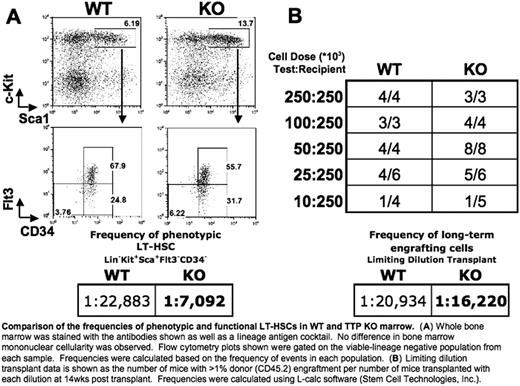Abstract
Abstract 2541
Poster Board II-518
The RNA binding protein TTP binds to AU-rich elements (AREs) located in the 3′UTR of mRNAs and dramatically reduces their half-life through exosome-mediated RNA degradation. TTP provides a conserved mechanism for the temporal and fine-tuning regulation of gene expression. We found that the Lin−Kit+Sca+ (KSL) population, a phenotypic marker combination that enriches for HSCs, in adult (6–8 week old) C57Bl/6 marrow expressed TTP mRNA at a level 25-fold higher than whole bone marrow mononucuclear cells. Furthermore, adult TTP KO mice had twice the number of KSL cells per mouse compared to WT littermates, with no difference in bone marrow cellularity. Thus, we reasoned that TTP might represent an as yet unexplored avenue for HSC regulation. The TTP KO mouse has been described previously* and displays myeloid hyperplasia, cachexia and arthritis. Consistent with the reported phenotype there was a 2-fold increase in the number of phenotypic granulocyte-monocyte progenitors (GMPs) and normal numbers of both common myeloid progenitors (CMPs) and megakaryocyte-erythroid progenitors (MEPs) in KO marrow. Within the KSL population of KO marrow, we observed an increase in the Flt3−CD34− fraction, which has been shown to be highly enriched for long-term HSCs (LT-HSCs). However, when we measured the frequency of functional long-term engrafting cells by limiting dilution competitive repopulation transplantation assays, there was no difference between WT and KO marrow. We also found no difference in the in vivo responses of WT and KO HSCs in chimeric transplant recipients to bi-monthly 5-FU injections for 18 weeks. We tested the hypothesis that the increase in the number of KSL cells is due to a lack of regulation of the Sca1 mRNA in KO marrow. In an RNA half-life assay in NIH3T3 cells, TTP had no effect on the half-life of a reporter message carrying the Sca1 3′UTR; whereas the TNFa 3′UTR, a known TTP target, did cause the half-life of the reporter message to decrease in the presence of TTP in our assay. Interestingly, the Lin−CD150+CD48−Kit+Sca+ labeling scheme gave a much more accurate representation of the relative frequency of HSCs in KO vs WT marrow. In studying HSC biology, the ability to prospectively identify alterations in the HSC compartment of genetically and pharmacologically manipulated marrow is of utmost importance. These studies demonstrate that in genetically manipulated marrow, the phenotypic and functional phenotypes are not always in accordance.
*Taylor GA and Blackshear PJ et al. Immunity (4) 1996
No relevant conflicts of interest to declare.
Author notes
Asterisk with author names denotes non-ASH members.


This feature is available to Subscribers Only
Sign In or Create an Account Close Modal